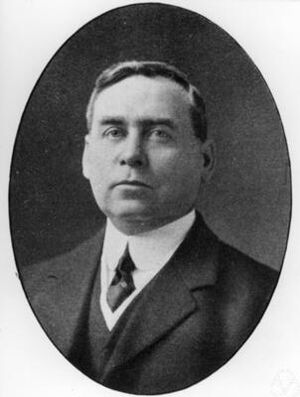John Charles Fields (nonfiction): Difference between revisions
| Line 23: | Line 23: | ||
== Nonfiction cross-reference == | == Nonfiction cross-reference == | ||
* [[Ferdinand Georg Frobenius (nonfiction)]] | |||
* [[Max Planck (nonfiction)]] | * [[Max Planck (nonfiction)]] | ||
* [[Mathematics (nonfiction)]] | * [[Mathematics (nonfiction)]] | ||
Latest revision as of 14:54, 10 July 2017
John Charles Fields, FRS, FRSC (May 14, 1863 – August 9, 1932) was a Canadian mathematician and the founder of the Fields Medal for outstanding achievement in mathematics. First awarded in 1936, the medal has been awarded since 1950 every four years at the International Congress of Mathematicians to two or four recipients under the age of 40.
Born in Hamilton, Ontario to a leather shop owner, Fields graduated from Hamilton Collegiate Institute in 1880 and the University of Toronto in 1884 before leaving for the United States to study at Johns Hopkins University in Baltimore, Maryland. Fields received his Ph.D. in 1887. His thesis, entitled Symbolic Finite Solutions and Solutions by Definite Integrals of the Equation dny/dxn = xmy, was published in the American Journal of Mathematics in 1886.
Fields taught for two years at Johns Hopkins before joining the faculty of Allegheny College in Meadville, Pennsylvania. Disillusioned with the state of mathematical research in North America at the time, he left for Europe in 1891, locating primarily in Berlin, Göttingen and Paris, where he associated with some of the greatest mathematical minds of the time, including Karl Weierstrass, Felix Klein, Ferdinand Georg Frobenius, and Max Planck. Fields also began a friendship with Gösta Mittag-Leffler, which would endure their lifetimes.
He began publishing papers on a new topic, algebraic functions, which would prove to be the most fruitful research field of his career.
Fields returned to Canada in 1902 to lecture at the University of Toronto. Back in the country of his birth, he worked tirelessly to raise the stature of mathematics within academic and public circles. He successfully lobbied the Ontario Legislature for an annual research grant of $75,000 for the university and helped establish the National Research Council of Canada, and the Ontario Research Foundation. Fields served as president of the Royal Canadian Institute from 1919 until 1925, during which time he aspired to mold the institute into a leading centre of scientific research, although with mixed success. His efforts, however, were pivotal in making Toronto the location of the 1924 International Congress of Mathematicians.
Fields is best known for his development of the Fields Medal, which is considered by some to be the Nobel Prize in Mathematics, although there are differences between the awards. First awarded in 1936, the medal was reintroduced in 1950 and has been awarded every four years since. It is awarded to two to four mathematicians, under the age of 40, who have made important contributions to the field. Fields began planning the award in the late 1920s but, due to deteriorating health, never saw the implementation of the medal in his lifetime.
He died on August 9, 1932 after a three-month illness; in his will, he left $47,000 for the Fields Medal fund.
In the News
Fiction cross-reference
Nonfiction cross-reference
External links:
- John Charles Fields @ Wikipedia
